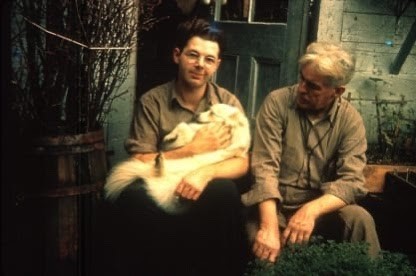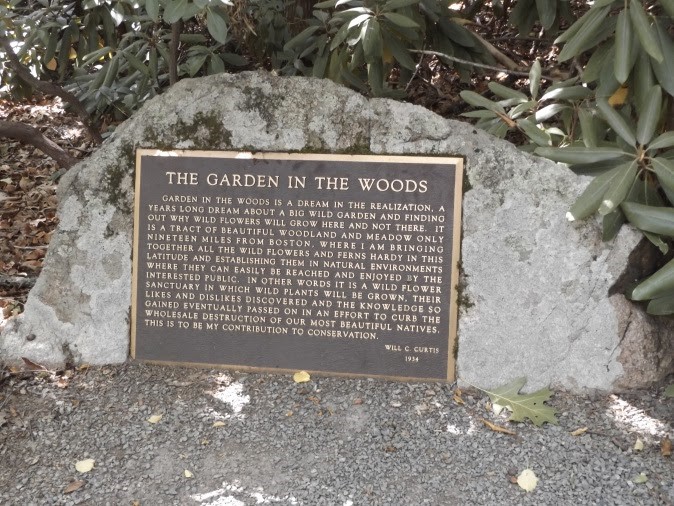In the Nobscot section of Framingham there lies a hidden paradise, a forty-five acre garden of native wildflowers. This garden, aptly called Garden in the Woods,was the dream of one man, Will C. Curtis (1883-1969).
Will, the eldest of three children, was born to Bryon C. Curtis and Emogene (Doughty) Curtis, in Schuylerville, New York. Young Will and his mother shared a love of plants. At the tender age of ten, he planted his first garden of wild plants under a pear tree, and at the age of twelve worked for a local florist.
By 1908, both of his parents were deceased, and Will assumed the responsibility of raising his younger brother and sister. This put his plans to attend college on hold. In 1919 at the age of thirty-six, he graduated from the Cornell University School of Agriculture with a degree in landscape architecture. Will’s first professional job was in Schenectady, New York where he laid out the city’s park system. He then went to work as a purchasing agent for a large leather company in Little Falls, New York. Missing outdoor work, Will left this job and moved to Massachusetts where he was employed by Warren H. Manning, a landscape architect in Billerica. At the time, Manning was considered the “Dean of Landscape Architecture.” Manning, who had previously worked for Frederick Law Olmstead, was a proponent of the informal, naturalistic school of gardening. Will, also of the naturalist school, was an eager student of Manning‘s. The naturalist school based their designs on patterns found in nature, and used native plants to create landscapes which seemed natural and not deliberately planned.
Will left Manning’s employ and came to Framingham. He was hired as the general manager of Little Tree Farms, a large nursery on Pleasant Street. In 1931 at the age of forty-eight while out hiking, Will discovered a thirty acre tract of land in rural north Framingham. He bought the acreage from the Old Colony Railroad for one thousand dollars. The railroad had used the land as a gravel mine. To Will, this naturally beautiful place with its eskers, brooks, bogs, pond, and varied woodland, was the perfect setting for a large wildflower garden.
After acquiring the land, Will and his friend Ormond Hamilton began developing the Garden. First he built a rustic house, then cleared garden areas, and laid out trails. While Will was a sensitive artist, he was also opinionated and brusque. This combination drove off many of the volunteers at the Garden. There was, however, one volunteer who stayed. In 1933, after losing his jobduring the Depression, Howard (Dick) Stiles joined Will and a lifelong partnership began. Although Stiles was not a formally trained horticulturist, he had a natural talent for landscape design and plant propagation.

The Garden was opened to the public in the early 1930s. It showcased Will’s talents in naturalist landscaping and native plants. By 1936, Dick became a full partner in the Garden. Under Will’s capable hands, the Garden evolved and flourished. Dick shared the workin the Garden, gave tours, sold plants, and developed a collection of exotic plants. Together, they created award winning exhibits for many flower shows. These exhibits and awards proved to be great advertising, drawing many visitors to their Garden in the Woods.
The Garden in the Woods was a sanctuary to protect native plant species. Over the years, Will took many expeditions to rescue plants, including one to the top of Mount Washington. Will and Dick amassed a vast amount of information on wildflowers and native American flowers. They kept accurate records, and maintained seed and information exchanges with many botanical gardens worldwide.
By the 1960s, Will was feeling his age. He had to cut back on his landscape design business which had supported the two men and the Garden in the Woods. Also, developers had discovered the northside of Framingham. New neighborhoods were springing up where farms and woods once were. When Will purchased the land, the closest neighbor was over a mile away. Now, there were houses across the street. With no direct heirs to take over the Garden in the Woods and ensure its survival, Will decided to turn it over to the New England Wildflower Preservation Society. In May of 1965, with all the details worked out and a successful endowment campaign completed, the agreement was signed. Will stayed on as Garden Director and Dick as Curator.
Will’s health began to fail. In 1967 he endured three operations which left him bed or wheelchair bound. Will died on October 26, 1969 at his home at Garden in the Woods. His ashes were scattered in his beloved garden.

Facts
- Curtis’ home at 180 Hemenway Rd. was demolished in 2017.
- $250,000 was raised for the Garden in the Woods endowment fund in 1965.
- Esker – A long ridge of post-glacial gravel in river valleys.
- The Garden in the Woods contains approximately 1,000 native plant species.
- Today the Garden in the Woods encompasses 45 acres; 15 additional acres were added by the NEWPS.
- Curtis won many awards for exhibits at the Massachusetts Horticultural Society Spring Show; The Garden Club of America Bulkley Medal at shows in Boston, New York, and Philadelphia; in 1935, a gold medal at the New York Horticultural Society Show.
- For 5 years in the 1960s, Curtis was an advisor to the Hubbard Trail in Weston, Massachusetts
Bibliography
Ayres, James. “40 Years of Botany Saved from Bulldozer.” Boston Globe (1960-1988), May 08, 1965, pp. 14. ProQuest, https://ezproxy.bpl.org/login?url=https://search-proquest-com.ezproxy.bpl.org/docview/276135199?accountid=9675. Accessed 12 July 2020.
Birnbaum, Charles A, and Julie K. Fix, editors. Pioneers of American Landscape Design II: an Annotated Bibliography. U.S. Dept. of Interior, National Park Service, Cultural Resources, Heritage Preservation Service, Historic Landscape Initiative. 1995. Google Books. https://www.google.com/books/edition/Pioneers_of_American_Landscape_Design_II/iwFrlWNr6QkChl=en&gbpv=1&dq=warren+h.+manning+billerica+ma+obituary&pg=PA38&printsec=frontcover Accessed 8 Aug. 2020.
“Byron C. Curtis.” Memorial no. 98224306. Find a Grave. https://www.findagrave.com/memorial/98224306/byron-c_-curtis#source Accessed 14 July 2020.
Cornell University. Cornell Alumni Directory. Vol. 13, no. 12. Ithaca, N.Y. : Cornell University, May 15, 1922. Google Books. https://books.google.com/booksid=Zn1y36bBlngC&pg=PP9&lpg=PP9&dq=cornell+alumni+directory&source=bl&ots=BeHSpdfWaq&sig=ACfU3U0cIUrBRd6I1gj5xrnnFFqz6HvXtg&hl=en&sa=X&ved=2ahUKEwizv4aT88fqAhUmlXIEHTn4BaIQ6AEwEnoECAoQAQ#v=onepage&q=cornell%20alumni%20directory&f=false Accessed 12 July 2020.
“Dream Comes True.” Boston Globe (1960-1988), Oct 30, 1966, pp. 1. ProQuest, https://ezproxy.bpl.org/login?url=https://search-proquest-com.ezproxy.bpl.org/docview/367033490?accountid=9675. Accessed 12 July 2020.
“Emogene A. Doughty Curtis.” Memorial no. 98224351. Find a Grave. https://www.findagrave.com/memorial/98224351/emogene-a_-curtis Accessed 14 July 2020.
Hotton, Peter. “Genius of Two Men Fashions Garden Gem: A Walk in Framingham
Eden.” Boston Globe (1960-1988), Jul 07, 1968, pp. 1. ProQuest, https://ezproxy.bpl.org/login?url=https://search-proquest-com.ezproxy.bpl.org/docview/365815076?accountid=9675. Accessed 12 July 2020.
Richardson, Mark. “A Master Plan for Garden in the Woods.” Ecological Landscape Alliance. Oct.13, 2013. https://www.ecolandscaping.org/10/designing-ecological-landscapes/native-plant s/a-master-plan-for-garden-in-the-woods/ Accessed 13 July 2020.
Stiles, Howard O. “Will C. Curtis – His Life.” American Rock Garden Society Bulletin, Vol. 28, no. 2, Apr. 1970. pp 63-64. https://nargs.org/sites/default/files/free-rgq downloads/VOL_28_NO_2.pdf Accessed 12 July, 2020.
Thayer, Lucien. “$250,000 Needed to Save Garden in Woods.” Boston Globe (1960-1988), Jun 21, 1964, pp. 1. ProQuest, https://ezproxy.bpl.org/login?url=https://search-proquest-com.ezproxy.bpl.org/docview/276425927?accountid=9675. Accessed 12 July 2020.
“Will C. Curtis, Framingham Landscaper.” “OBITUARIES.” Boston Globe (1960-1988), Oct 27, 1969, pp. 26. ProQuest, https://ezproxy.bpl.org/login?url=https://search-proquest-com.ezproxy.bpl.org/docview/375411820?accountid=9675. Accessed 12 July 2020.